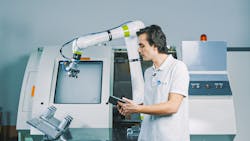The future of robotic integration and collaborative robots
Kristian Hulgard is general manager, Americas division, at OnRobot.
As industrial robot installations continue to rise, they continue to be integrated into work cells for palletizing, machine tending, welding and other industrial applications. What innovative or efficient robot-integration applications have you seen or been involved with?
Kristian Hulgard, general manager, Americas division, OnRobot: Right now, end-of-line automation is very popular. Palletizing is especially hot for a variety of reasons. It’s physically demanding work. It’s increasingly difficult to find and retain workers for manual positions like palletizing. And palletizing is well understood in terms of automation.
In terms of efficient robot integration, I have fully installed a collaborative palletizing application in less than day. This covers the entire deployment process from arriving at the facility with the hardware, setting it in place and running our software. There was a blank space in the factory the day before, but, seven hours later, the company had a fully functional automated palletizing cell. This type of efficiency just hasn’t been possible before. It's innovative on both the hardware and the software side, and it's extremely efficient in terms of robot integration.
What have been the biggest improvements to robot integration and interoperability with other robots or components in work cells in the past five years?
Kristian Hulgard, general manager, Americas division, OnRobot: One of the biggest improvements has been the transition to fully electric and software-controlled end-of-arm tooling (EOAT). The adaptable, intelligent EOAT can replace traditional pneumatic- or hydraulic-powered hardware across many material-handling applications. Electric EOAT is not just more intelligent than its traditional counterparts; it’s also easier to integrate with your industrial robot arm.
Most manufacturers of automation hardware aim for easy interoperability in an effort to lower the barriers to automation adoption. Not all achieve this goal. Those that do are manufacturers that make it easy for end users to get all the components in the work cell communicating and working together.
Can you explain how software or open-source control architectures have changed robotic integration?
Kristian Hulgard, general manager, Americas division, OnRobot: The emergence of no-programming-required deployment software is a game-changer for automation because it cuts the cost and complexity traditionally associated with setting up robot cells. This type of software not only handles the integration between different components in the cell, but it also enables easy application setup, as well as monitoring and remote analytics. As it develops, software like this will solve many integration problems.
As the need for automation rises, so does the need for engineering human resources, but there’s already a shortage of robot integrators. By exploring software-enabled alternatives we can enable robotics integrators to do more. However, for that to happen, we need artificial intelligence (AI), we need more advanced software solutions, and we need to incorporate tools that minimize the deployment time on each application.
As manufacturers and warehouses/distribution centers push toward autonomous operations, what is the benefit of collaborative robots (cobots) and their ability to work alongside humans?
Kristian Hulgard, general manager, Americas division, OnRobot: My somewhat controversial answer here is that in the next 10 to 15 years there simply won’t be that much of a difference between a standard industrial robot and a collaborative robot.
From speed and payload capabilities to usability and safety, all of these features are being introduced in both industrial robots and collaborative robots. You could question the value of using a safe, collaborative robot if you are not planning to have people around the robot. But there are so many other factors that determine the type of robot you're going to use, from small footprint to ease of use. Fifteen years down the road, as the lines between collaborative and traditional industrial automation continue to blur, I don't think the distinction between the two will matter that much, if it exists at all.
When will robotics technology become user-friendly enough that integration installation and operation is plug and play and no longer requires extensive engineering?
Kristian Hulgard, general manager, Americas division, OnRobot: It’s here already, thanks to no-programming-required automated deployment software. We might not have arrived on every single type of application yet, but non-experts can easily deploy simple applications, such as palletizing, CNC machine tending and packaging. With the right software, a completely untrained operator can install an entire robotic cell.
Future developments will see this ground-breaking deployment software scaled out to incorporate more complex applications and capabilities for handling multiple robots. The sky's the limit.
What future innovations will impact the integration of robotics technology in work cells and with other industrial machinery?
Kristian Hulgard, general manager, Americas division, OnRobot: The software used on automation platforms will become more sophisticated and able to support more hardware and more robots. At the same time, robotics software will become even easier to use, regardless of the complexity of the project. So, no matter what type of application you want to install, even if it's a unique one-off application, the software will be able to handle the integration, making deployment even more of a plug-and-play experience with no expertise required. This scenario is a few years down the road. But this is the direction the automation sector is taking.
Tell us about your company’s state-of-the-art robotic integration into a work cell or transporting materials/goods between cells.
Kristian Hulgard, general manager, Americas division, OnRobot: The International Federation of Robotics estimates that programming and integration account for between 50-70% of the cost of a typical robot application. This cost is a major obstacle to automation adoption, particularly for small to medium size enterprises.
OnRobot is relentlessly focused on breaking down these barriers to automation adoption and deployment through a combination of plug-and-play hardware peripherals and easy-to-use software. Additionally, our entire range of easy-to-use, all-electric hardware peripherals, from sanding end effectors to vacuum grippers, are designed to be compatible with all leading cobot and lightweight industrial robot brands, further simplifying the deployment process.
The launch of our D:Ploy software is the culmination of OnRobot’s work to make deploying automation accessible to non-experts, slashing deployment times in the process. Currently available for palletizing, transferring, CNC, and packaging applications, with more applications coming, D:Ploy is a software tool that automatically deploys the whole application for you, eliminating programming altogether. D:Ploy does the programming for you.
D:Ploy automatically discovers most of the installed hardware and generates the robot motion based on the obstacles and cell boundaries defined in the workspace. Program logic, signals exchange, event handling and robot movement are automatically created for the application based on a few inputs such as workpiece attributes, pick position and cell boundaries. D:Ploy automates the robot deployment process across the entire cell including the robot arm and EOAT.
Take a palletizing application, as an example. Using D:Ploy to deploy a palletizing cell, it could be ready to go within just three hours. Similarly, a manufacturer could redeploy a palletizing cell in 2.5 hours. Meanwhile, a typical CNC machine tending application can be done in 6 hours.
D:Ploy also provides remote monitoring and automatic diagnostics features for real-time and historic views and alerts. It’s a complete, automated platform for building, running, monitoring and re-deploying collaborative automation.
About the Author
Mike Bacidore
Editor in Chief
Mike Bacidore is chief editor of Control Design and has been an integral part of the Endeavor Business Media editorial team since 2007. Previously, he was editorial director at Hughes Communications and a portfolio manager of the human resources and labor law areas at Wolters Kluwer. Bacidore holds a BA from the University of Illinois and an MBA from Lake Forest Graduate School of Management. He is an award-winning columnist, earning multiple regional and national awards from the American Society of Business Publication Editors. He may be reached at [email protected]

Leaders relevant to this article:


